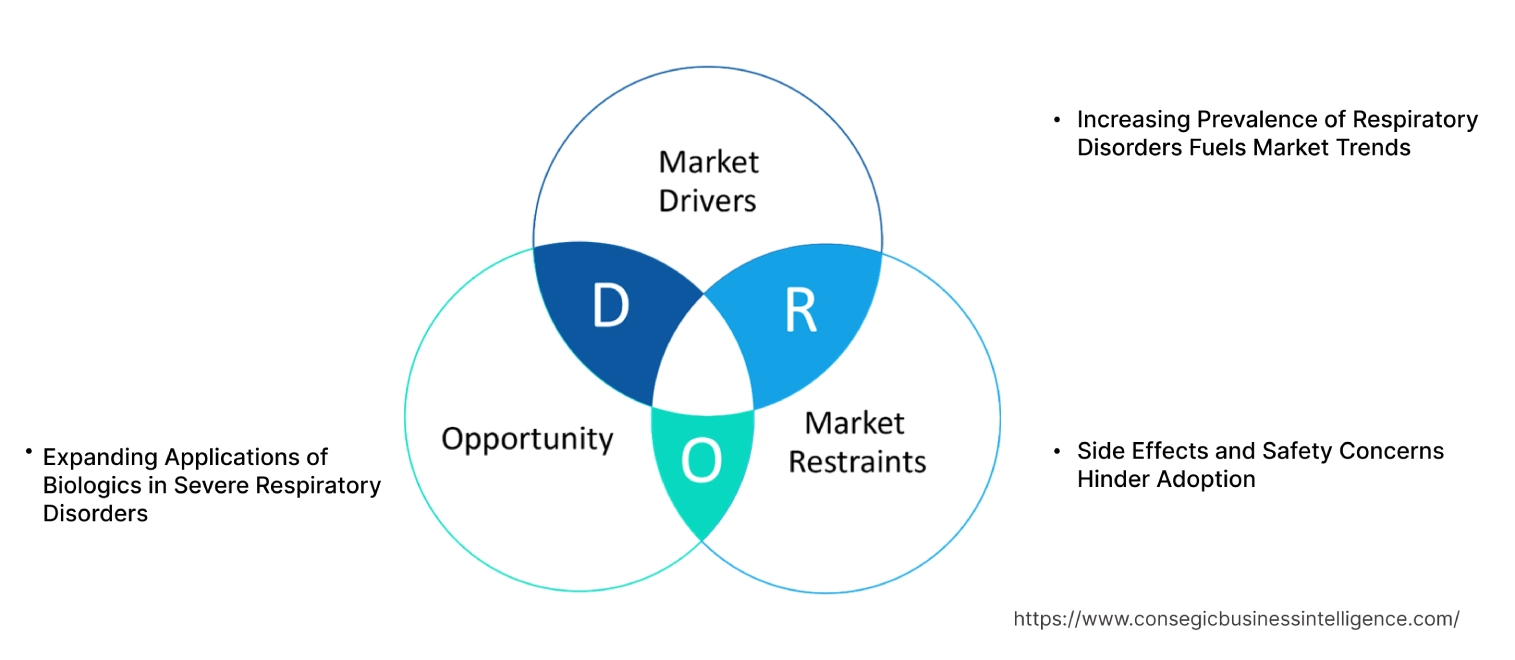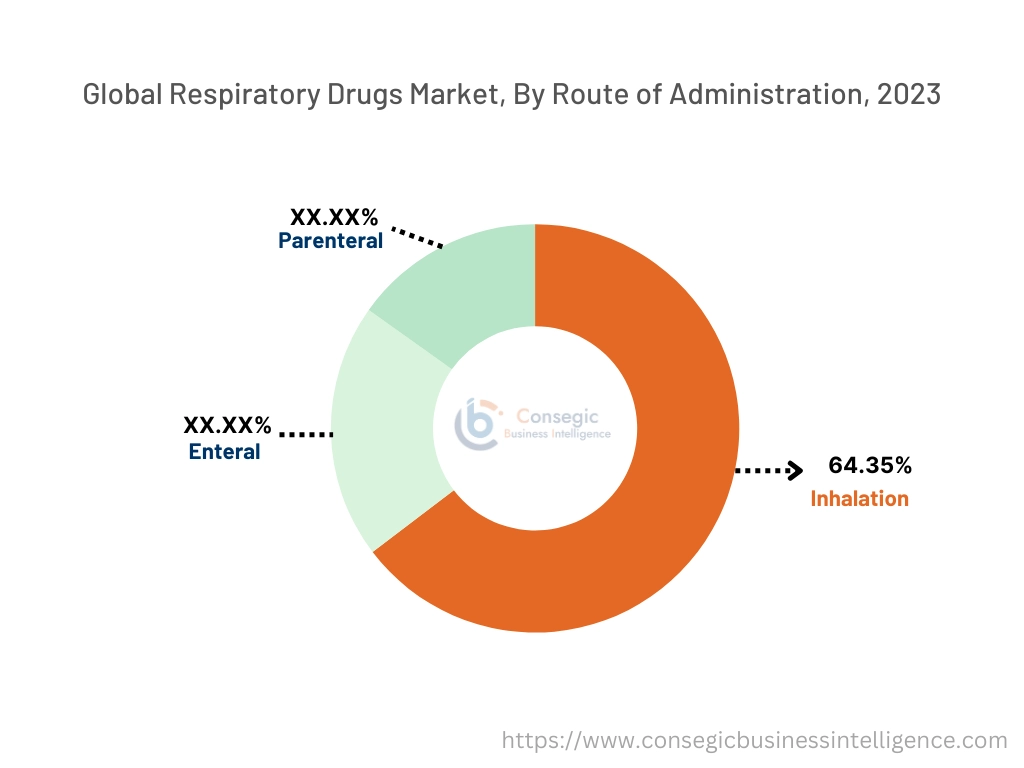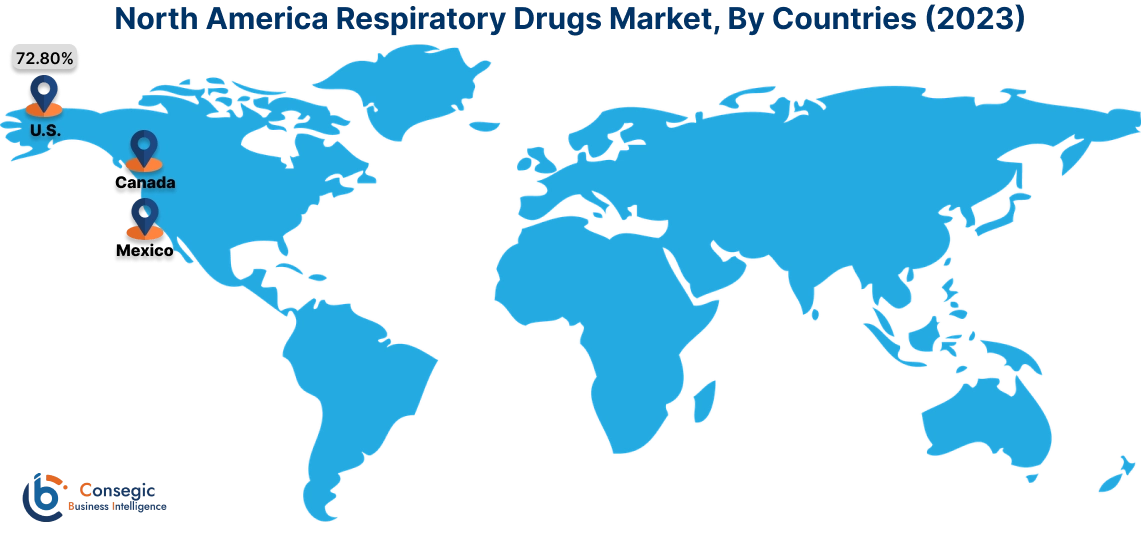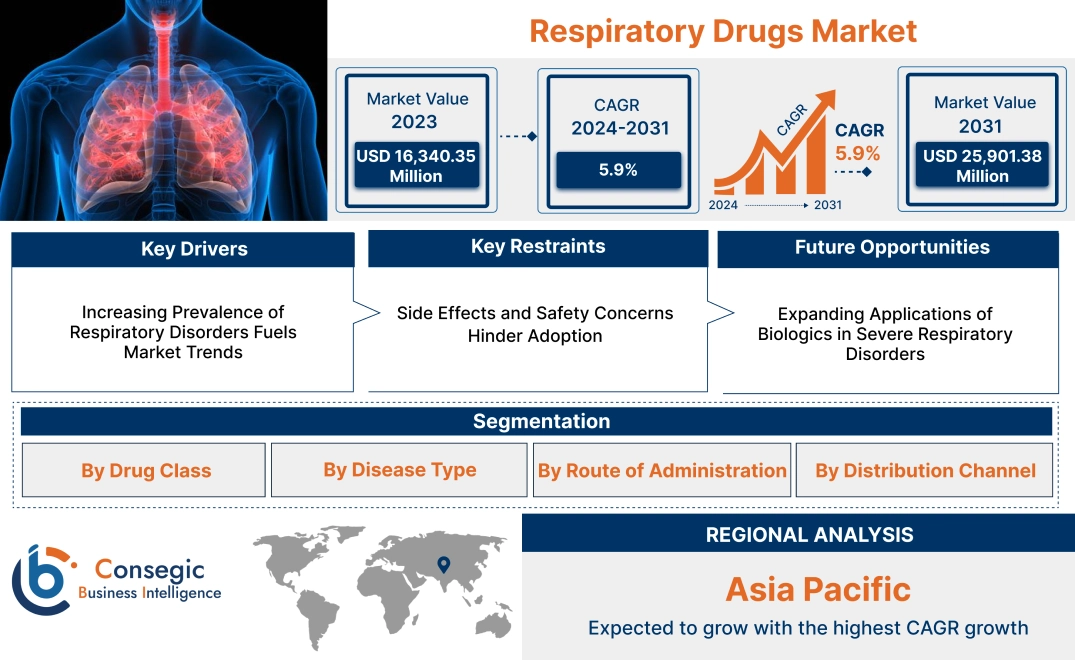Respiratory Drugs Market Size:
Respiratory Drugs Market size is estimated to reach over USD 25,901.38 Million by 2031 from a value of USD 16,340.35 Million in 2023 and is projected to grow by USD 17,017.82 Million in 2024, growing at a CAGR of 5.9% from 2024 to 2031.
Respiratory Drugs Market Scope & Overview:
The respiratory drugs focus on medications designed to treat a range of respiratory conditions, including asthma, chronic obstructive pulmonary disease (COPD), pulmonary hypertension, and respiratory infections. These drugs encompass various formulations, such as inhalers, nebulizers, tablets, and injectables, offering targeted delivery to the respiratory system. Key characteristics of respiratory drugs include rapid onset of action, high efficacy, and compatibility with advanced drug delivery systems. The benefits include improved lung function, reduced symptoms, and enhanced quality of life for patients. Applications span emergency treatments, chronic disease management, and prophylactic therapies. End-users include hospitals, clinics, home healthcare settings, and pharmacies, driven by the increasing prevalence of respiratory diseases, advancements in drug delivery technologies, and rising awareness about early diagnosis and treatment of respiratory conditions.
How is AI Transforming the Respiratory Drugs Market?
AI is being increasingly used in the respiratory drugs market. AI-powered solutions are being used for transforming drug discovery, precision medicine, and patient care. AI solution accelerates the identification of promising drug compounds, simulates drug interactions, and optimizes inhaled drug delivery for conditions like asthma and others. It enables personalized treatment plans by analyzing patient data, improves device design, and supports remote monitoring and medication adherence through smart inhalers and other tools. In addition, AI-powered systems can streamline drug production processes, which ensures higher efficiency and improved scalability to meet growing market demands. Thus, the above factors are projected to drive the market growth during the forecast period.
Respiratory Drugs Market Dynamics - (DRO) :

Key Drivers:
Increasing Prevalence of Respiratory Disorders Fuels Market Trends
The rising incidence of respiratory disorders, including asthma, chronic obstructive pulmonary disease (COPD), and pulmonary fibrosis, is a significant factor driving a surge in the respiratory drugs market. Urbanization and industrialization have exacerbated air pollution levels, contributing to a higher prevalence of these conditions, particularly in densely populated areas. Smoking, occupational hazards, and aging populations further increase the risk of respiratory diseases. The World Health Organization (WHO) has highlighted that COPD and asthma rank among the leading causes of morbidity and mortality globally, emphasizing the growing need for effective treatment options.
In response to this technology, there are increasing respiratory drugs market opportunities in the adoption of advanced respiratory medications such as bronchodilators, inhaled corticosteroids, and combination therapies. Innovations in drug formulations and delivery mechanisms, including metered dose inhalers (MDIs) and dry powder inhalers (DPIs), are enhancing treatment efficacy and patient compliance. Additionally, initiatives promoting early diagnosis and awareness of respiratory health are accelerating the adoption of these therapies, shaping the market's growth trajectory.
Key Restraints :
Side Effects and Safety Concerns Hinder Adoption
Despite their effectiveness, the potential side effects associated with respiratory drugs pose a significant challenge to their adoption. Long-term use of corticosteroids, a common treatment for asthma and COPD, is associated with adverse effects such as weakened immunity, osteoporosis, hypertension, and hyperglycemia. Similarly, biologics and targeted therapies, while effective for severe and refractory conditions, carry risks of allergic reactions, increased susceptibility to infections, and high costs. These concerns lead to hesitation among healthcare providers and patients, particularly in cases where alternative therapies may be considered safer.
The need for comprehensive patient education and monitoring during treatment further complicates the adoption of advanced respiratory drugs. Patients often require guidance on managing potential side effects and understanding proper inhaler techniques to maximize efficacy while minimizing risks. These challenges emphasize the need for ongoing innovation to reduce adverse effects and improve the safety profile of respiratory therapies, which is critical for achieving broader adoption.
Future Opportunities :
Expanding Applications of Biologics in Severe Respiratory Disorders
The use of biologics in managing severe and refractory respiratory conditions represents a transformative in the market. Biologic therapies, such as anti-IgE and anti-IL-5 monoclonal antibodies, target specific pathways involved in asthma and COPD, providing highly effective treatment options for patients unresponsive to conventional therapies. For example, biologics like omalizumab and mepolizumab have demonstrated significant efficacy in reducing asthma exacerbations and improving lung function in severe cases.
As research into the molecular mechanisms of respiratory diseases advances, the development of next-generation biologics is expanding its applications to include conditions like idiopathic pulmonary fibrosis (IPF) and eosinophilic asthma. The increasing respiratory drugs market opportunities focus on precision medicine and biomarker-driven therapies is further supporting this respiratory drugs market trend, allowing for more targeted and personalized treatments. With ongoing innovation and favorable clinical outcomes, biologics are poised to play a central role in the management of complex respiratory disorders, driving development and reshaping the market landscape.
Respiratory Drugs Market Segmental Analysis :
By Drug Class:
Based on drug class, the respiratory drugs market is segmented into short-acting beta2-agonists (SABA), long-acting beta2-agonists (LABA), inhaled corticosteroids (ICS), anticholinergics, antihistamines, vasodilators, combination drugs, and others.
The combination drugs segment accounted for the largest revenue share in 2023.
- Combination drugs, which include a mix of bronchodilators and corticosteroids, are extensively used to treat complex respiratory conditions such as asthma and COPD.
- Their ability to address multiple symptoms simultaneously while improving treatment adherence drives their adoption across healthcare settings.
- The increasing prevalence of chronic respiratory conditions and the trend of adopting personalized medicine in respiratory care are further boosting the demand for combination drugs.
- Additionally, the introduction of advanced inhalation devices tailored for combination therapies is supporting the development of this segment.
- Combination drugs dominate the market due to their efficacy in managing chronic respiratory conditions and the increasing opportunities to focus on comprehensive, patient-centric treatment solutions.
The inhaled corticosteroids (ICS) segment is anticipated to register the fastest CAGR during the forecast period.
- ICS are widely used for reducing inflammation and managing respiratory conditions like asthma and COPD.
- The aim toward early intervention in chronic conditions and the growing awareness of inflammation control in respiratory care are key drivers for this segment.
- Furthermore, advancements in inhalation technologies, such as metered-dose inhalers (MDIs) and dry powder inhalers (DPIs), have improved the delivery efficiency of ICS, further accelerating their adoption.
- Inhaled corticosteroids are expected to grow rapidly due to their critical role in inflammation control and advancements in inhalation delivery systems.
By Disease Type:
Based on disease type, the market is segmented into asthma, chronic obstructive pulmonary disease (COPD), allergic rhinitis, cystic fibrosis, and others.
The asthma segment accounted for the largest revenue share in 2023.
- Asthma is one of the most prevalent respiratory conditions globally, affecting millions of individuals across all age groups.
- The increasing adoption of inhalation-based therapies, combined with the trend of adopting long-term management plans for asthma patients, is driving the applications for respiratory drugs in this segment.
- Additionally, ongoing research and development efforts to introduce biologics and advanced therapies for severe asthma are contributing to its market dominance.
- Asthma leads the market, driven by its high prevalence and the increasing adoption of advanced therapies for long-term management.
The COPD segment is anticipated to register the fastest CAGR during the forecast period.
- Chronic obstructive pulmonary disease is a major cause of morbidity and mortality worldwide, with increasing cases due to smoking and environmental pollution.
- The demand for advanced bronchodilators, combination therapies, and inhalation devices for effective COPD management is rising.
- The tendency to adopt telemedicine and remote monitoring solutions for COPD patients is further enhancing treatment adherence and boosting the segment's advancement.
- COPD is expected to grow rapidly, fueled by the increasing prevalence of the disease and the trend of adopting advanced therapies and remote monitoring solutions.
By Route of Administration:
Based on the route of administration, the respiratory drugs market is segmented into inhalation, enteral, and parenteral.
The inhalation segment accounted for the largest revenue of 64.35% in the respiratory drugs market share in 2023.
- Inhalation is the preferred route of administration for most respiratory drugs due to its ability to deliver medication directly to the lungs, ensuring faster and more effective relief.
- The increasing adoption of advanced inhalation devices, such as MDIs, DPIs, and nebulizers, is driving the respiratory drugs market demand in this segment.
- The advancement toward patient-friendly, portable inhalation devices is further enhancing the adoption of this route across all age groups.
- Inhalation dominates the market due to its direct and efficient drug delivery mechanism, supported by advancements in inhalation device technology.
The parenteral segment is anticipated to register the fastest CAGR during the forecast period.
- Parenteral administration is increasingly used for severe respiratory conditions requiring immediate intervention, such as acute asthma attacks and severe COPD exacerbations.
- The growing trend of using biologics and injectable formulations for advanced respiratory therapies is driving this segment.
- Additionally, the availability of long-acting injectable drugs is contributing to the rising adoption of the parenteral route.
- Parenteral administration is expected to grow rapidly, driven by the increasing use of biologics and the respiratory drugs market trend of adopting long-acting injectable formulations for severe respiratory conditions.

By Distribution Channel:
Based on the distribution channel, the market is segmented into hospital pharmacies, retail pharmacies, and online pharmacies.
The hospital pharmacies segment accounted for the largest revenue in the respiratory drugs market share in 2023.
- Hospital pharmacies are the primary point of distribution for respiratory drugs, especially for severe cases requiring immediate intervention.
- The increasing number of hospital admissions due to acute respiratory conditions and the availability of specialized therapies in hospital settings are driving this segment.
- The trend of equipping hospital pharmacies with biologics and advanced drug formulations for critical care is further supporting its dominance.
- Hospital pharmacies lead the market due to their role in providing advanced therapies and managing acute respiratory conditions effectively.
The online pharmacies segment is anticipated to register the fastest CAGR during the forecast period.
- Online pharmacies are gaining popularity due to their convenience, particularly among patients requiring regular prescriptions for chronic respiratory conditions.
- The trend of adopting digital therapeutics platforms and the increasing availability of discounts and subscription models for respiratory drugs are driving the development of this segment.
- Additionally, the rising use of telemedicine services is further enhancing the adoption of online pharmacies.
- Online pharmacies are expected to grow rapidly, driven by the trend of adopting digital healthcare platforms and the increasing convenience offered to chronic condition patients.
Regional Analysis:
The regions covered are North America, Europe, Asia Pacific, the Middle East and Africa, and Latin America.

In 2023, North America was valued at USD 5,420.23 Million and is expected to reach USD 8,394.64 Million in 2031. In North America, the U.S. accounted for the highest share of 72.80% during the base year of 2023. North America's analysis depicts it dominates the respiratory drugs market, driven by a high prevalence of respiratory diseases such as asthma, chronic obstructive pulmonary disease (COPD), and allergies. The U.S. respiratory drugs market analysis leads the region due to advanced healthcare infrastructure, strong R&D activities, and widespread adoption of combination therapies for respiratory disorders. The increasing prevalence of smoking-related lung conditions and rising air pollution levels further drive a surge for respiratory medications. Canada contributes to the market with growing awareness of respiratory health and government support for affordable drug access. However, the high costs of novel therapies and regulatory hurdles can limit market expansion in the region.

In Asia Pacific, the market is experiencing the fastest growth with a CAGR of 6.4% over the forecast period. As per the analysis, Asia-Pacific is the fastest-growing region in the respiratory drugs market, driven by rising pollution levels, increasing prevalence of smoking, and growing awareness of respiratory health. The respiratory drugs market analysis depicts that China, India, and Japan are the major contributors to respiratory drugs market growth. China’s high air pollution levels and increasing cases of respiratory conditions such as asthma and COPD are driving demand for inhaled therapies. Japan’s aging population and focus on precision medicine are boosting the adoption of targeted biologics for severe respiratory diseases. India is experiencing strong advancement in affordable respiratory medications due to its large population and rising burden of chronic diseases. However, limited access to advanced therapies and affordability challenges in rural areas hinder market development.
According to the analysis Europe is a significant market for respiratory drugs, supported by a strong focus on healthcare access and increasing cases of chronic respiratory diseases. Countries like Germany, the UK, and France are leading the market with high adoption rates of inhaled corticosteroids, bronchodilators, and combination therapies. Germany’s advanced pharmaceutical industry and the UK’s focus on early diagnosis and treatment of respiratory conditions contribute to market growth. France is witnessing an increase in demand for biologics targeting severe asthma and COPD. However, stringent regulatory requirements and pricing pressures in the European Union can challenge market expansion.
The Middle East & Africa region is experiencing steady advancement in the respiratory drugs market analysis, driven by the increasing prevalence of respiratory disorders such as asthma and COPD. Countries like Saudi Arabia and the UAE are focusing on improving healthcare infrastructure and raising awareness about respiratory health. The high incidence of respiratory infections in Africa is driving demand for affordable medications, including bronchodilators and corticosteroids. However, limited access to advanced treatments and inadequate healthcare infrastructure in several African countries pose challenges to market growth.
Latin America is an emerging market for respiratory drugs, with Brazil and Mexico leading the region. Rising cases of asthma and COPD due to pollution and smoking are driving the respiratory drugs market demand for respiratory medications in these countries. Brazil’s strong focus on improving healthcare access and increasing public awareness about respiratory health is supporting respiratory drugs market growth. Mexico’s growing pharmaceutical industry and government initiatives to enhance access to essential medicines contribute to market expansion. However, economic instability and limited availability of biologics and advanced therapies in some areas restrict market growth.
Top Key Players & Market Share Insights:
The respiratory drugs market is highly competitive with major players providing products and services to the national and international markets. Key players are adopting several strategies in research and development (R&D), product innovation, and end-user launches to hold a strong position in the global respiratory drugs market. Key players in the respiratory drugs industry include -
- AstraZeneca (United Kingdom)
- Hoffmann-La Roche Ltd. (Switzerland)
- Boehringer Ingelheim International GmbH (Germany)
- Sanofi (France)
- Regeneron Pharmaceuticals Inc. (United States)
- Teva Pharmaceuticals (Israel)
- Novartis AG (Switzerland)
- GSK plc (United Kingdom)
- Merck & Co. (United States)
- Grifols, S.A. (Spain)
Respiratory Drugs Market Report Insights :
| Report Attributes | Report Details |
| Study Timeline | 2018-2031 |
| Market Size in 2031 | USD 25,901.38 Million |
| CAGR (2024-2031) | 5.9% |
| By Drug Class |
|
| By Disease Type |
|
| By Route of Administration |
|
| By Distribution Channel |
|
| By Region |
|
| Key Players |
|
| North America | U.S. Canada Mexico |
| Europe | U.K. Germany France Spain Italy Russia Benelux Rest of Europe |
| APAC | China South Korea Japan India Australia ASEAN Rest of Asia-Pacific |
| Middle East and Africa | GCC Turkey South Africa Rest of MEA |
| LATAM | Brazil Argentina Chile Rest of LATAM |
| Report Coverage |
|
Key Questions Answered in the Report
What is the projected size of the Respiratory Drugs Market by 2031? +
Respiratory Drugs Market size is estimated to reach over USD 25,901.38 Million by 2031 from a value of USD 16,340.35 Million in 2023 and is projected to grow by USD 17,017.82 Million in 2024, growing at a CAGR of 5.9% from 2024 to 2031.
What are the main drivers of growth in the Respiratory Drugs Market? +
Key drivers include the increasing prevalence of respiratory disorders such as asthma and COPD, advancements in drug delivery technologies, and rising awareness about early diagnosis and treatment of respiratory conditions.
What are the major challenges faced by the market? +
Safety concerns and side effects associated with long-term use of respiratory drugs, especially corticosteroids and biologics, hinder their broader adoption. High costs of advanced therapies also pose a challenge.
Which disease type contributes the most to the market? +
Asthma accounts for the largest share, driven by its high global prevalence and increasing adoption of inhalation-based therapies and advanced treatments.

